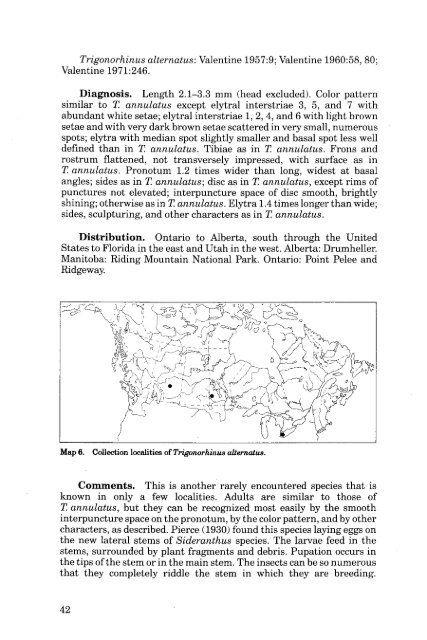Weevils - Entomological Society of Canada
Weevils - Entomological Society of Canada
Weevils - Entomological Society of Canada
You also want an ePaper? Increase the reach of your titles
YUMPU automatically turns print PDFs into web optimized ePapers that Google loves.
T rigonorhinu s alternatus : Valentine Ig57 :9 ; Valentine 1960 : 58, 80 ;<br />
Valentine 797I:246.<br />
Diagnosis. Length 2.I-3.3 mm (head excluded). Color pattern<br />
similar to T. annulatus except elytral interstriae 3, 5, and 7 with<br />
abundant white setae; elytral interstriae 1,2, 4, and 6 with light brown<br />
setae and with very dark brown setae scattered in very small, numerous<br />
spots; elytra with median spot slightly smaller and basal spot less well<br />
defined than in T. annulqtus. Tibiae as in Z annulatus. Frons and<br />
rostrum flattened, not transversely impressed, with surface as in<br />
T. annulatus. Pronotum 1.2 times wider than long, widest at basal<br />
angles; sides as in T. annulafzzs; disc as in Z annulatus, except rims <strong>of</strong><br />
punctures not elevated; interpuncture space <strong>of</strong> disc smooth, brightly<br />
shining; otherwise as in Z annulatus. Elytra 1.4 times longer than wide;<br />
sides, sculpturing, and other characters as in ? annulatus.<br />
Distribution. Ontario to Alberta, south through the United<br />
States to Florida in the east and Utah in the west. Alberta: Drumheller.<br />
Manitoba: Riding Mountain National Park. Ontario: Point Pelee and<br />
Ridgeway.<br />
Map 6. Collection localities <strong>of</strong> Trigonorhinus ahernatue.<br />
Comments. This is another rarely encountered species that is<br />
known in only a few localities. Adults are similar to those <strong>of</strong><br />
T. annulatus, but they can be recognized most easily by the smooth<br />
interpuncture space on the pronotum, by the color pattern, and by other<br />
characters, as described. Pierce (1930) found this species laying eggs on<br />
the new lateral stems <strong>of</strong> Siderqntius species. The larvae feed in the<br />
stems, surrounded by plant fragments and debris. Pupation occurs in<br />
the tips <strong>of</strong> the stem or in the main stem. The insects can be so numerous<br />
that they completely riddle the stem in which they are breeding.<br />
42

















